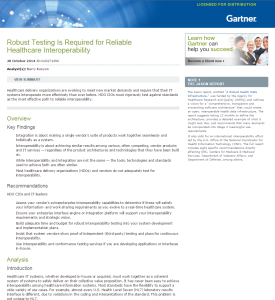 In his recently published Research Note, Gartner Research Vice President, Barry Runyon has mentioned the AEGIS Developers Integration Lab (DIL). We are proud to be included in this report and we know that the DIL is the kind of interoperability testing resource desperately needed by the healthcare IT industry.
In his recently published Research Note, Gartner Research Vice President, Barry Runyon has mentioned the AEGIS Developers Integration Lab (DIL). We are proud to be included in this report and we know that the DIL is the kind of interoperability testing resource desperately needed by the healthcare IT industry.
The DIL is the only testing solution that performs conformance testing at the level of overall message, discrete message element, message segment, and complete end-to-end message exchanges. This results in seamless coverage of all stages of testing: from development through User Acceptance Testing (UAT) and pre-production or certification support.
Mr. Runyon states, “most healthcare systems vendors and health delivery organizations (HDOs) are not prepared to do disciplined and exhaustive interoperability testing that is necessary for reliable interoperability. Interoperability testing is necessary to mitigate risk and conformance testing must be built into the software development life cycle, HDO systems implementation initiatives and purchasing decisions. HDOs should demand vendors show proof of independent (third party) testing and continuous interoperability.”
“…HDOs and independent software vendors that serve [them] will test their interoperability capabilities through…Testing through third-party interoperability and conformance testing service providers.” – Barry Runyon, VP Gartner Research
AEGIS believes standards-based, interoperable health IT solutions are necessary for effective and secure health information data exchange. AEGIS continues to disrupt, in a very positive way, by educating clinicians, consumers, employers, hospitals and health systems, government agencies, standards development organizations, patient safety organizations and technology companies on the importance of continuous interoperability testing in order to protect patient safety. In addition, interoperability provides an effective tool in combating health-related fraud, waste, and abuse.
Interoperability involves at least two systems that need to remain in step with each other as they exchange and interpret shared information. A change to one exchange partner’s system could affect interoperability with all its other partners. Decisions made by one organization’s CIO can impact that organization’s interoperability with many other organizations. AEGIS emphasizes the criticality that the systems that want to share information conform to standards otherwise they can’t understand each other. Assuring interoperability and conformance depends in turn upon effective testing. The bottom line is that interoperability testing cannot be viewed in terms of a point in time – because once that point in time has passed, interoperability can no longer be assured. One of the hardest aspects to understand when it comes to interoperability testing is that it must be continuous. Only when testing for continuous interoperability is in place can stakeholders be assured that their information sharing initiatives will likewise carry on without interruption. Continuous interoperability requires a robust automated testing approach and tools that focus on that important outcome.
Reference: Gartner Robust Testing is Required for Reliable Healthcare Interoperability, Barry Runyon, 28 October 2014.

